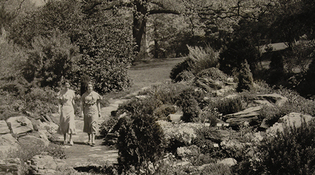 loading
loading
Arts & CultureYale’s secret gardenObject lesson: In the 1920s and ’30s, landscape architect Beatrix Farrand made her mark on Yale. Karyl Evans is a six-time Emmy Award–winning documentary filmmaker and an associate fellow of Jonathan Edwards College. Her films include The New Haven Green: Heart of a City and The Life and Gardens of Beatrix Farrand.  Manuscripts & ArchivesThe rock garden designed by Beatrix Farrand as part of Yale’s Marsh Botanical Garden is shown here in 1935. The garden has since grown over, but from the late 1920s through the ’30s it was enjoyed by thousands every year. View full imageHidden among the overgrown rhododendrons and hemlocks, a once remarkable rock garden lies dormant inside the gates of Yale University’s Marsh Botanical Garden. Interlopers can still find massive boulders and a secluded pond, wander along a path of stepping stones, and identify a wide range of plants, among them ferns and trilliums. When you enter this secret garden, you can almost sense a once-grand existence, although today the eight-acre plot at the intersection of Prospect Street and Hillside Place is barely noticeable to the passerby. Even so, it forms part of the legacy at Yale of one of the country’s pioneering landscape architects. This rock garden, and indeed the entire Marsh Botanical Garden, was designed by the distinguished landscape architect Beatrix Farrand, who served as landscape consultant for Yale from 1922 to 1945. Farrand is credited with designing about 75 percent of the Yale campus during her tenure, working on projects as diverse as the residential college court-yards, the president’s house, the divinity school, the planted moats throughout campus, and the medical school. Educated at Harvard and Columbia and steeped in the landscape tradition of Italy and France, she was one of the founding members of the American Society of Landscape Architects. The land that became the Marsh Botanical Garden was given to Yale in 1899 by Professor O. C. Marsh, Class of 1860, for the “purposes of a University Botanical Garden and for no other use or purpose.” The creation of the rock garden began in 1928 with the precise placement of a large number of imported boulders, the installation of a winding path of stepping stones, and the planting of over 1,000 species. Farrand devoted a great deal of thought to the choice of flora, collecting specimens for years and procuring seeds and rare alpine specimens from Harvard’s Arnold Arboretum. She considered rock gardens not only the most challenging type of garden, but also “more beautiful than any other form of gardening art.” She intended the entire Marsh Botanical Garden to provide an example of excellence in landscape design, which she believed vital to a complete education. This historic photograph shows two visitors taking a stroll through the rock garden in 1935. They would have been among the 10,000 who explored the Marsh Botanical Garden every May and June in the late 1920s and throughout the 1930s. Multitudes came to see the extensive beds of tulips and irises, a systematic garden that took as its model one in Padua, Italy (it was reputed to be the world’s oldest), and, of course, the extensive rock garden. But after Farrand retired from her position in 1945, and due in part to the financial difficulties of World War II, the demanding upkeep of the university’s landscape plan became difficult. Much of her work went into decline. As a horticulture and landscape architecture student, and now as a longtime member of the Garden Club of New Haven, I can only imagine what a spectacular resource the Marsh Botanical Garden once was, not only for Yale’s scientific community, but also for students in the arts, citizens of greater New Haven, and visitors from around the country. Walking through the almost unrecognizable rock garden today, with all of the boulders still in place—waiting like sentinels for the action to start—the thought of seeing this magical secret garden brought back to life is indescribably alluring. It is like wanting to see a masterwork restored to its fullest potential, to allow it to educate and inspire once again.
The comment period has expired.
|
|